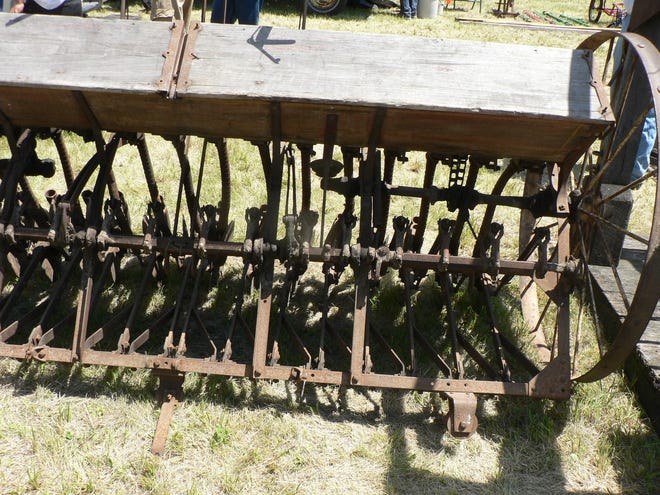Old machinery tells the story of technology and innovation that made farming easier

It's those days we want to remember and cherish that happened when we were growing up and raising families. And somehow or other those days seem to get better the older we get.
What do you think draws so many people to the dozens of antique farm equipment shows held across the state from spring through fall? It's the memories.
One of the biggest such shows in Wisconsin is the annual Rock River Thresheree held for four days ending on Labor Day at Thresherman's Park ( its permanent site) between Edgerton and Janesville.

Mr. Maytag's invention was a blessing to farmwives
The antique farm machinery shows have one thing in common: They are about memories. The first tractor you drove in 1948, the plow you used in the 1950s and the Maytag washing machine grandmother used before the farm even had electricity evoke memories of the past.
A washing machine at a farm equipment show? Certainly. Many of the shows have expanded to cover other aspects of the good old days. Why not washing machines, pump jacks and two-cylinder hit-and-miss engines? For sure, while granddad was cranking the old Fordson tractor, grandmom was busy washing his overalls — without electricity. The Maytag Company was featured at a recent Rock River Thresheree, and I'll admit I learned a good bit about the Maytag wringer washer my mother used so long ago.
Maytag is a name dear to the hearts of farmers. First, at its beginning in 1873, the company made corn shredders and parts for threshing machines. But more important to the non-electrified farming community was the wringer washing machine.
According to an Iowa PBS documentary, company founder Fred L. Maytag grew up with the hard work of farm life and knew the drudgery that the farm wife faced as well as the farmer. He built his first washer in 1907 to bring his agricultural equipment company company through the slow-selling season.
Maytag introduced the "Hired Girl" machine in 1909. Two years later the company would add an electric motor to the square-tubbed machine and in 1914 Maytag developed a gasoline-powered engine that brought real clothes-washing to America's farms.
Many folks at the Rock River Thresheree stopped to look at the old Maytags and several remarked that they didn't know how the women could use them. It looked like running clothes through the rubber wringer was a lot of work and, of course, it was.

Corn sled made harvesting corn less backbreaking
Then there was the corn sled exhibited by William Anderson of Edgerton. The V-shaped, sled-like contraption had two steel blade wings that cut the corn as one horse pulled it between two 40-inch corn rows. The corn was gathered in by two men riding on the sled.
"I don't know who manufactured this machine," Anderson says, "but, it was probably a move up from cutting the corn by hand and was replaced by the corn binder."
Hand pumps still fascinate the public
The old water well pumps found on every farm before electrification always seem to draw a crowd at these events. While the pumps became outdated with the advent of electricity, folks are naturally curious when they see working hand pumps on occasion at parks and historical sites.
During the "good old days", hand pumps were used to fill household water buckets and could be attached to a windmill for livestock watering. Then small gasoline engines came on the scene and another need was filled by technology.
These one- and two-cylinder engines are popular among collectors today and most antique equipment shows will have a few or maybe many. Again, old and young visitors look with awe, some remembering cranking the flywheel as a kid, others in wonderment that they worked and how simple they were.

Internal combustion engine has ties to Madison, Wisconsin
The first company to make an internal combustion engine tractor was the Hart-Parr Tractor Company, and it all started in Madison. Charles Hart and Charles Parr were students in the mechanical engineering department at the University of Wisconsin. To earn special honors at graduation, Hart and Parr wrote an extensive thesis in 1896 describing the history and development of internal combustion engines. As part of their report, they built a 2-cylinder vertical valve-in-head engine. Unfortunately, not one of those engines has yet to be found. T
When financing to build a larger factory was unavailable in Madison, the pair moved their Wisconsin manufacturing operations to Hart's hometown of Charles City, Iowa in 1901.
Of course, antiques are about memories. The long-gone cloth seed corn bags from Blaneys Seeds in Fitchburg and Olds Seeds in Madison still bring special memories to southern Wisconsin residents.
Then there are the glass milk bottles, the lanterns used on farms in pre-electricity days along with the wooden cheese boxes that I knew as a youngster. One such box of course is the old Kraft boxes.
The good old days are whatever you want to make them. The plethora of antique farm equipment shows will help you remember or make you wonder what happened to the years that have passed since farmers used the equipment on display.
John F. Oncken can be reached at at jfodairy2@gmail.com